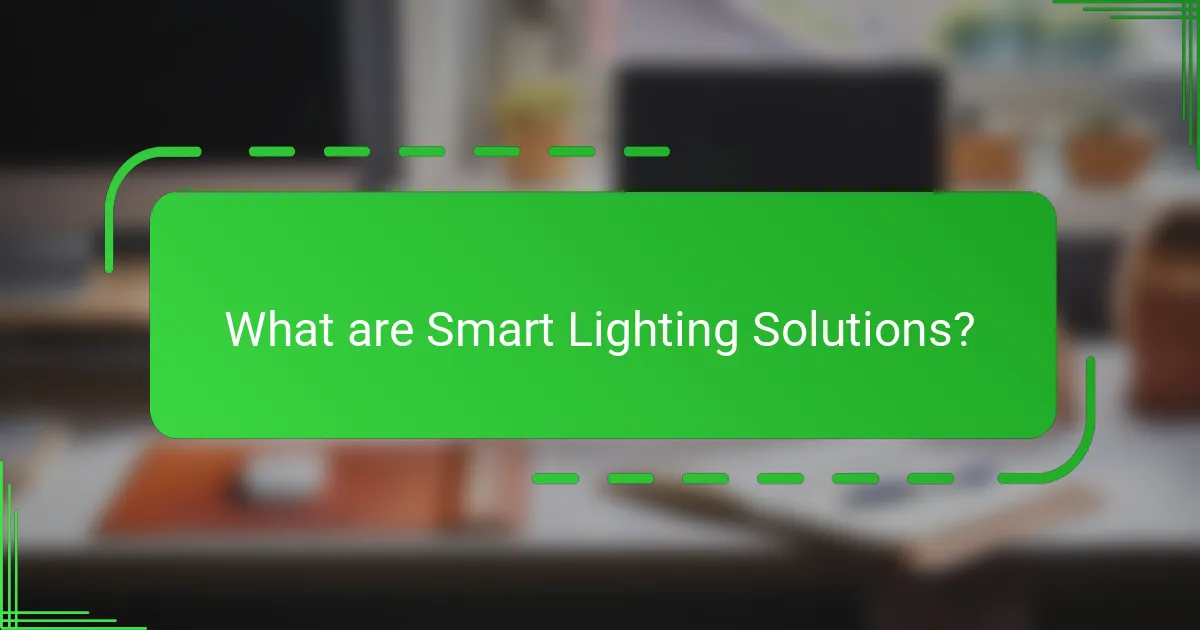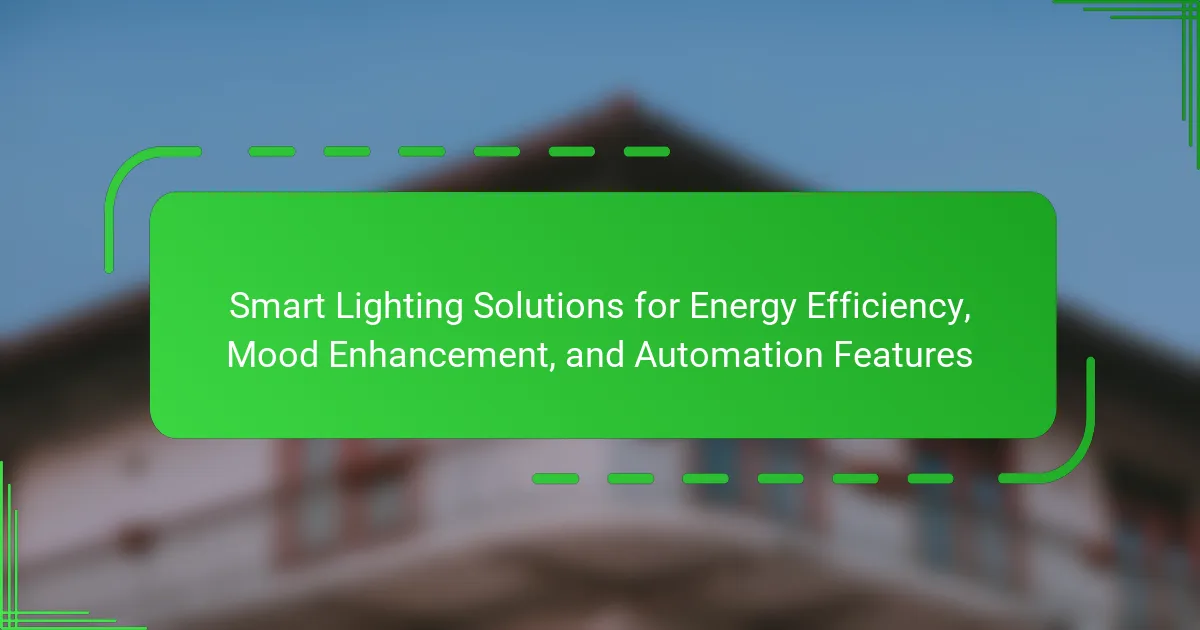Smart lighting solutions are advanced systems designed for remote control and programmable functions, primarily using LED technology for energy efficiency. These systems allow users to adjust brightness, color, and timing via mobile applications or voice commands. Integration with home automation enhances user experience, creating various lighting atmospheres that can improve mood and productivity. Smart lighting also incorporates sensors to optimize energy consumption based on occupancy, making it increasingly popular in residential and commercial environments. The article explores the benefits of smart lighting, including its impact on energy efficiency, mood enhancement, and automation features.

What are Smart Lighting Solutions?
Smart lighting solutions are advanced lighting systems that can be controlled remotely and programmed for various functions. These systems often utilize LED technology for energy efficiency. Smart lighting allows users to adjust brightness, color, and timing through mobile apps or voice commands. Many smart lighting solutions integrate with home automation systems. They can enhance mood by creating different lighting atmospheres. Studies show that proper lighting can improve productivity and well-being. Additionally, smart lighting can reduce energy consumption by using sensors to adjust light levels based on occupancy. This technology is increasingly popular in both residential and commercial settings.
How do Smart Lighting Solutions contribute to energy efficiency?
Smart lighting solutions contribute to energy efficiency by utilizing advanced technologies to optimize energy consumption. These systems often include sensors that adjust lighting based on occupancy and natural light levels. By automatically dimming or turning off lights when spaces are unoccupied, they reduce wasted energy.
Additionally, smart lighting solutions frequently incorporate LED technology, which consumes significantly less power than traditional incandescent bulbs. According to the U.S. Department of Energy, LED lights use at least 75% less energy and last 25 times longer than incandescent lighting.
Furthermore, smart lighting can be programmed for specific schedules, ensuring that lights are only on when needed. This targeted approach minimizes unnecessary energy usage throughout the day. Overall, smart lighting solutions enhance energy efficiency through automation, advanced technologies, and energy-saving designs.
What technologies are used in Smart Lighting Solutions for energy savings?
Smart lighting solutions for energy savings utilize several key technologies. These include LED technology, which consumes significantly less energy than traditional incandescent bulbs. Smart sensors, such as motion detectors, adjust lighting based on occupancy, reducing waste. Wireless connectivity, often through Wi-Fi or Zigbee, enables remote control and automation, optimizing energy use. Dimming capabilities allow lights to adjust brightness according to natural light levels. Smart lighting systems can also incorporate scheduling features to turn off lights when not needed. According to the U.S. Department of Energy, LED lighting can save up to 75% energy compared to incandescent lighting. These technologies collectively enhance energy efficiency in smart lighting solutions.
How do Smart Lighting Solutions compare to traditional lighting in terms of energy consumption?
Smart lighting solutions significantly reduce energy consumption compared to traditional lighting. Smart lighting systems can use up to 80% less energy by utilizing LED technology and adaptive controls. Traditional incandescent bulbs typically consume more energy, with an average efficiency of only 10-17 lumens per watt. In contrast, smart LED bulbs can achieve efficiencies of 80-100 lumens per watt. Additionally, smart lighting allows for automation and scheduling, which further decreases energy usage. Studies show that homes using smart lighting can save an average of 30% on their electricity bills. This efficiency stems from features like motion sensors and dimming capabilities. Overall, smart lighting solutions present a more energy-efficient alternative to conventional lighting methods.
What role do Smart Lighting Solutions play in mood enhancement?
Smart lighting solutions significantly enhance mood by adjusting light intensity and color. These systems can mimic natural light patterns, which positively influence circadian rhythms. Studies show that exposure to specific light wavelengths can boost serotonin levels, improving mood. For example, blue light is known to increase alertness and reduce feelings of tiredness. Additionally, customizable settings allow users to create environments that suit their emotional needs. Smart lighting can also promote relaxation through warm tones in the evening. Overall, these solutions provide a dynamic way to influence emotional well-being through lighting design.
How does lighting color affect mood and ambiance?
Lighting color significantly affects mood and ambiance. Different colors evoke specific emotional responses. Warm colors like red and orange can create feelings of warmth and comfort. They often stimulate energy and excitement. Cool colors such as blue and green promote calmness and relaxation. Research shows that blue light can enhance focus and productivity. In contrast, harsh white light can lead to feelings of stress or discomfort. Studies indicate that lighting color influences psychological well-being. According to a study published in the Journal of Environmental Psychology, color temperature impacts perceived space and mood. Thus, selecting appropriate lighting colors can enhance emotional experiences in various environments.
What are the psychological benefits of using Smart Lighting Solutions?
Smart lighting solutions can enhance psychological well-being. They allow users to adjust brightness and color, influencing mood. Research shows that warm lighting can promote relaxation. Bright, cool lighting can increase alertness and productivity. These adjustments can help reduce stress and anxiety. Studies indicate that personalized lighting improves overall satisfaction in living spaces. Smart lighting can also support circadian rhythms, improving sleep patterns. Better sleep contributes to improved mental health and cognitive function.
What automation features are available in Smart Lighting Solutions?
Smart lighting solutions offer various automation features. These include scheduling, which allows users to set specific times for lights to turn on or off. Another feature is motion sensing, enabling lights to activate when movement is detected. Dimming capabilities permit adjusting brightness levels automatically based on ambient light. Some systems support remote control via smartphone apps, allowing users to manage lighting from anywhere. Integration with smart home systems enhances automation by syncing lights with other devices. Voice control features enable users to operate lights using voice commands. These automation features contribute to energy efficiency and improved user experience.
How can Smart Lighting Solutions be integrated with home automation systems?
Smart lighting solutions can be integrated with home automation systems through compatible smart hubs and protocols. These systems typically use Wi-Fi, Zigbee, or Z-Wave for communication. Smart bulbs and fixtures connect to the hub, allowing centralized control. Users can manage lighting through mobile apps or voice assistants. Automation features enable scheduling and scene setting based on user preferences. Integration enhances energy efficiency by optimizing lighting usage. For example, smart lighting can adjust based on occupancy or natural light levels, reducing energy waste.
What are the benefits of scheduling and remote control in Smart Lighting Solutions?
Scheduling and remote control in Smart Lighting Solutions enhance convenience and energy efficiency. Users can set specific times for lights to turn on or off, ensuring optimal use. This feature reduces energy waste by avoiding unnecessary lighting when not needed. Remote control allows users to adjust lighting from anywhere, increasing flexibility. For instance, users can turn off lights left on accidentally. Additionally, scheduling can align with daily routines, promoting comfort and safety. Studies show that automated lighting can lead to a 20% reduction in energy consumption. Overall, these features contribute to a more efficient and user-friendly lighting experience.
How do Smart Lighting Solutions enhance user experience?
Smart lighting solutions enhance user experience by providing customizable lighting environments. Users can adjust brightness and color temperature to suit their preferences. This flexibility promotes comfort and productivity in various settings. Additionally, smart lighting can be automated to respond to user habits. For example, lights can turn on and off based on occupancy or time of day. Studies show that personalized lighting can improve mood and reduce eye strain. Furthermore, integration with smart home systems allows for seamless control through voice or mobile apps. This convenience increases user satisfaction and engagement with their environment.
What feedback mechanisms are available for users of Smart Lighting Solutions?
Users of Smart Lighting Solutions have several feedback mechanisms available. These include mobile applications that provide real-time updates and control options. Users can adjust settings and receive notifications through these apps. Voice-activated assistants also offer feedback by responding to user commands. Many systems include built-in sensors that provide data on energy usage and performance. Users can access this data to optimize their lighting settings. Additionally, some solutions offer integration with smart home systems for centralized feedback. User surveys and feedback forms may also be utilized for product improvement. These mechanisms help users enhance their experience and efficiency with smart lighting.
How do user preferences influence Smart Lighting Solutions’ settings?
User preferences significantly influence Smart Lighting Solutions’ settings by allowing customization based on individual needs. Users can adjust brightness, color temperature, and scheduling to match their activities and moods. For instance, a user may prefer warmer tones during the evening for relaxation. Additionally, preferences dictate automation features, such as motion detection and remote control capabilities. Research indicates that 70% of users appreciate personalized lighting adjustments for energy savings and comfort. Smart systems learn from user interactions, further refining settings over time to enhance user satisfaction. This adaptability makes Smart Lighting Solutions more effective and user-friendly.
What are the best practices for implementing Smart Lighting Solutions in homes?
The best practices for implementing Smart Lighting Solutions in homes include assessing lighting needs, selecting compatible devices, and ensuring proper installation. Begin by evaluating each room’s lighting requirements. This helps in choosing the right type and number of smart bulbs. Next, opt for devices that are compatible with existing home automation systems. This ensures seamless integration and control.
Installation should follow manufacturer guidelines for optimal performance. It is important to set up a centralized control system, such as a smartphone app or smart home hub. This allows for easy management of lighting schedules and settings. Additionally, utilizing motion sensors can enhance energy efficiency by automatically turning lights on or off based on occupancy.
Finally, regularly updating the firmware of smart devices is crucial for security and performance improvements. These practices collectively enhance energy efficiency, mood enhancement, and automation features in smart lighting solutions.
How can users effectively choose the right Smart Lighting Solutions for their needs?
Users can effectively choose the right Smart Lighting Solutions by assessing their specific needs and preferences. First, identify the purpose of the lighting, such as energy efficiency, mood enhancement, or automation features. Next, consider compatibility with existing smart home systems, ensuring seamless integration. Evaluate the types of bulbs available, including LED and smart bulbs, which offer various brightness and color options. Check for features like dimming capabilities, scheduling, and remote control functions. Review product ratings and customer feedback to gauge reliability and performance. Lastly, establish a budget, as prices for smart lighting solutions can vary significantly. This structured approach ensures users select solutions that align with their lifestyle and requirements.
What common troubleshooting tips should users know for Smart Lighting Solutions?
Check the power supply to ensure the smart light is receiving electricity. Verify that the smart light is connected to the correct Wi-Fi network. Restart the smart lighting device if it becomes unresponsive. Ensure the companion app is updated to the latest version for optimal performance. Check for any firmware updates available for the smart lighting system. If the smart light is flickering, check the bulb’s compatibility with the fixture. Reset the smart light according to the manufacturer’s instructions if issues persist. Consult the user manual for specific troubleshooting steps related to your smart lighting model.
Smart lighting solutions are advanced systems that enable remote control and automation of lighting, primarily using LED technology for energy efficiency. These solutions enhance mood and productivity by allowing users to adjust brightness and color, while also integrating with home automation systems for optimal energy consumption. Key features include motion sensing, scheduling, and remote control capabilities, which collectively contribute to significant energy savings and improved user experiences. The article explores the technologies behind smart lighting, their psychological benefits, and best practices for implementation, providing a comprehensive overview of their role in modern living environments.
